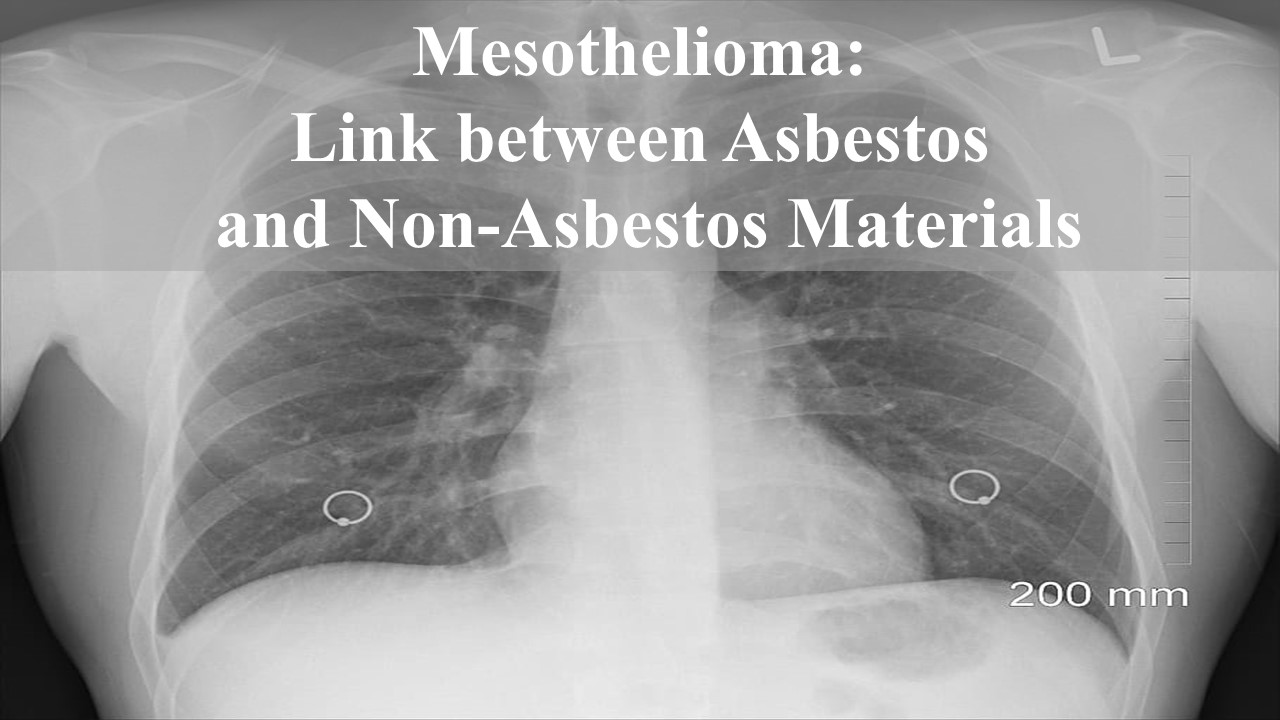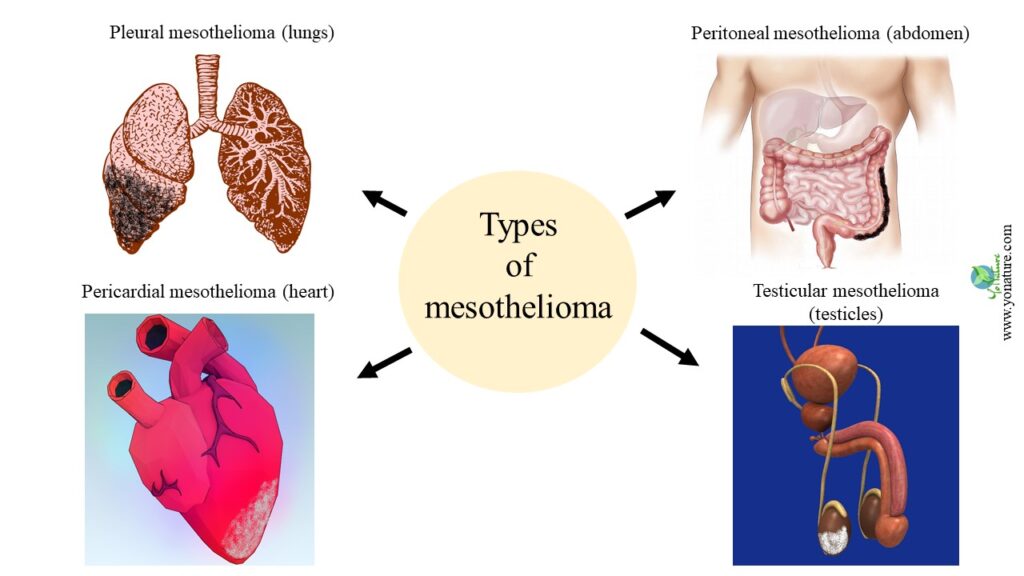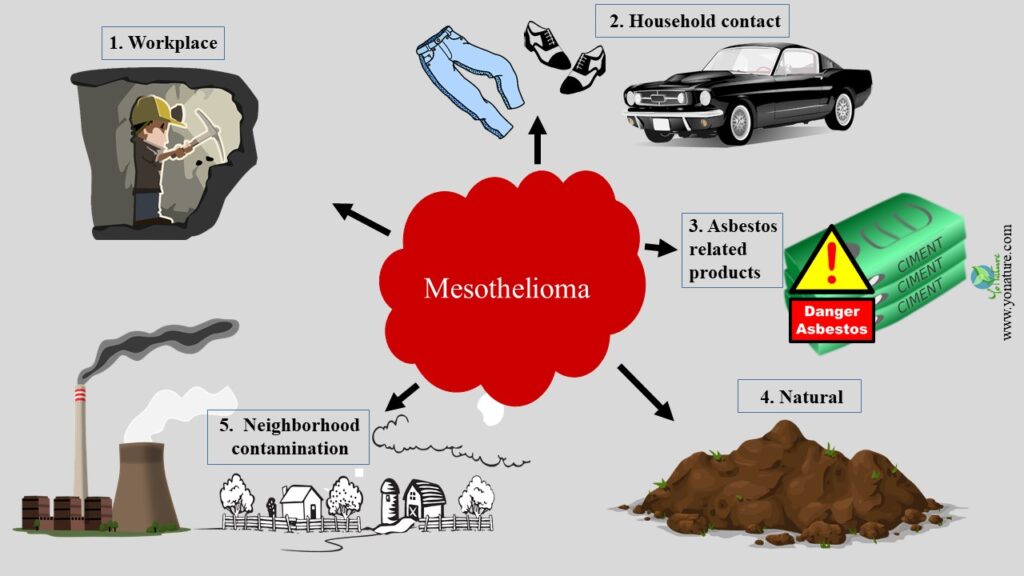Mesothelioma: Link between Asbestos and Non-Asbestos Materials

Mesothelioma is an aggressive cancer that occurs primarily due to contact with asbestos. It occurs mainly in the linings of the lungs and sometimes even in the abdomen. While in many countries the number of mesothelioma cases has reached a plateau, in others it has just started to peak. This is because it takes a long time for the symptoms to appear.
Unfortunately, asbestos is not banned globally. Its extraction and use is still ongoing in many developing countries like China and Kazakhstan.
What is asbestos?
Asbestos occurs naturally in the environment as fibrous minerals. It includes chrysotile (white asbestos), crocidolite (blue asbestos), amosite, anthophylite, tremolite and actinolite. Among these, chrysotile is most commonly used by approximately 95%.
Asbestos is very resistant, both physically and chemically and also poorly conducts heat. Because of these reasons, people use it for a wide range of purposes.
Uses of asbestos
Historical use
The peak of asbestos use was in fact during the 1930s to 1970s. During that time period, people used asbestos in more than 3,000 products. It was typically added to insulating materials because of its high heat resistance. Additionally, people used it heavily in the construction industry to make cement, roofing materials and insulation.
Also, in the 1940s to 60s, many people in countries like Japan and Europe used Asbestos Cement Pipes to distribute drinking water and carry sewage.
Common use today
As researchers understood its health impacts, many countries started to ban asbestos products in the 1970s starting with Denmark.
Nevertheless, today, we can still find asbestos in old buildings, automotive parts and fireproofing materials. It is also an important element in many products like roof shingles, some cigarette filters and talcum powder and hairdryers.
Why is asbestos dangerous?
As it is, when people breathe in asbestos, it leads to some serious health issues. It can induce various lung diseases like pneumoconiosis and fibrosis as well as pleural plaques and effusions. Asbestos also causes cancers in the linings of organs such as the lungs, larynx and ovaries. More dangerously though is the formation of mesothelioma that is unfortunately incurable.
Death related to asbestos
Thus, as asbestos is a lethal cancer-causing agent, the WHO-IARC classifies all asbestos minerals as Group 1 carcinogens. Every year, more than 100,000 die because of asbestos-related diseases. Right now, more than 125 million people are exposed to asbestos at their workplace. On top of that, several thousand people die due to asbestos-related products in their home.
How does mesothelioma develop?
As people inhale asbestos fibres, they make their way to the linings and sides of the lungs. As a result, they lead to chronic lung inflammation and stimulate cancer development.
Initially, asbestos can stimulate the overexpression of some growth factors. Or cause some genetic changes and mutations in mesothelial cells that cover the lungs, abdomen and heart.
Eventually, it can cause cells to proliferate or inhibit them from dying. As the cells develop in this way, they stack upon each other forming cancerous mass.
Benign and malignant mesothelioma
Thus, mesothelioma can be benign or malignant.
The benign form is non-cancerous and occurs quite rarely. In general, it develops in specific places, does not spread out and can be removed with surgery. In some cases, though, benign mesothelioma can become malignant.
The malignant form is actually the dangerous one that, to date, has no cure. The cancerous mass quickly spreads in the body and its management is very complex. Consequently, patients with malignant mesothelioma can live one to two years after diagnosis.
Types of mesothelioma
Four types of mesothelioma exist based on the organs in which they occur. They are:
- Pleural mesothelioma: it is the most common form of the disease and typically occurs in the linings of the lungs.
- Peritoneal mesothelioma: affects the linings of the abdomen.
- Pericardial mesothelioma: it occurs in the linings of the heart and is quite rare.
- Testicular mesothelioma: it develops in the testicles and occurs in less than 1% of all cases.

Treating mesothelioma
There are three main ways that physicians treat mesothelioma: chemotherapy, surgery and radiotherapy.
Unfortunately, most of the time, the cancer resists chemotherapy as the disease is already at an advanced stage.
Similarly, the procedure for surgery is also very complicated. It depends on various factors like health status, cancer stage and expert teams.
As for radiotherapy, it basically only relieves pain in mesothelioma patients. It is now considered a controversial procedure and is no longer recommended.
Link between mesothelioma and asbestos
The link between mesothelioma and asbestos was first put forward by Wagner in 1960. Following his published findings, asbestos controls started.
However, the precise way in which asbestos causes mesothelioma is still debated. Some of the hypotheses include chronic pleural irritation, persistent kinase-mediated signalling and the generation of toxic oxygen radicals.
The incidence of mesothelioma around the world reflects industrialization and the commercial use of asbestos. Rates are also higher in males as they work directly with asbestos products. As countries adopt asbestos safety measures and bans, models indicate that the disease will peak and disappear.
How are people exposed to asbestos?
People relate to asbestos via the following routes: workplace, household contact, neighbourhood contamination, asbestos-related products and naturally.
1. Workplace
The most common way in which people get into contact with asbestos is at their workplace. Since the workers are in direct contact with the minerals, they are more likely to suffer from health issues.
Workers especially at risk include those working in asbestos cement industries, shipyards, mining and insulator factories.
2. Household contact (take-home exposure)
Also, another danger associated with people working with asbestos is that they unconsciously carry the mineral back home. Thus, they indirectly expose their family members and close ones to asbestos.
This can be through their clothes, vehicles or items that they use at work.
3. Neighborhood contamination
Additionally, communities living near places where asbestos is extracted, processed or used, are also at risk of health issues. In fact, neighbourhood contamination is quite common for people who live near such local facilities.
Asbestos can spread through the air during loading and unloading of the minerals or during processing stages. It can also occur during the disposal of waste or when asbestos accidentally pollutes the environment.
4. Asbestos-related products
Though asbestos-related products have been banned in many countries, there are still many others that still use it. What’s more, some products still contain asbestos as a legacy of past use.
In the US alone, asbestos may affect 1.3 million construction and industry workers during demolition or restoration of old buildings.
5. Naturally occurring
As it is, asbestos occurs naturally in the environment. These are basically fibrous minerals that exist in rocks and soils. The concentration is very low though compared to mining sites.
Nonetheless, human activities that disrupt the soil and rock conditions can release asbestos into the air. Examples of such activities are road construction and soil extraction activities.

Non-asbestos products that cause mesothelioma
Additionally, there are other materials that cause mesothelioma besides asbestos. They include mineral fibres, radiation, chronic inflammation and spontaneous mesothelioma.
1. Mineral fibres
Some mineral fibres that typically look like asbestos can also cause the disease. This includes erionite, a mineral that exists mainly in volcanic rocks. It occurs mainly in the intermountain west of the US, Turkey and Italy.
There is also fluoro-edenite, a mineral fibre found in rocks. Large uses of the minerals in Italy induced several cases of pleural mesothelioma.
Additionally, balangeroite is another mineral that is contaminated by up to 0.5% white asbestos. Consequently, it, too, is associated with mesothelioma formation.
Over the years, researchers also discovered that some man-made fibres can take a fibrous form and pose health problems. Some examples are carbon nanotubes, rock wool, glass fibre, and slag wool.
2. Radiation
Radiation is generally accepted as a common source of cancer, including mesothelioma. People working directly with radiation have the highest risk of developing malignant mesothelioma.
3. Chronic inflammation
Also, in some cases, certain chronic inflammatory conditions can stimulate cancer cells to develop. People who suffer from tuberculosis or chronic empyema are especially at risk.
4. Spontaneous mesothelioma
Sometimes, it can also happen that mesothelioma develops without any link to asbestos or other cancer-related substances. Such spontaneous mesothelioma can occur in children, women and men that have no identifiable external cause.
Why is the number of mesothelioma cases rising?
Generally speaking, malignant mesothelioma is a rare form of cancer. It can occur from 10 cases in the US to 29 cases per million in Australia and the UK. In some countries, the occurrence of mesothelioma seems to be currently stable such as the US with 3200 cases per year. In other countries, especially Europe, it may start to peak as from 2020.
This is because there is a long delay period before the symptoms appear. It can be anywhere between 30 to 50 years. As people worked with and used asbestos heavily in the 1970s in developed countries, the disease is emerging after so many years.
Sometimes also, physicians can also inaccurately diagnose mesothelioma as lung cancer.
Future of mesothelioma
Unfortunately, only 54 countries have banned asbestos so far. People in many developing countries especially China, India and Kazakhstan still extract and use it on large scales. The WHO thus reports that cases of mesothelioma in such countries will inevitably rise in the next decades.
Mesothelioma legal help
Legal help for mesothelioma patients is available mainly in the US. In European countries, compensation systems for asbestos-related diseases are still evolving. And in developing countries, there is no such help.
Mesothelioma claims
As it happens, many employers actually expose their workers to asbestos in their workplace. Thus, if a person is diagnosed with mesothelioma, he/she can make claims against the asbestos-related company. The company will then provide finance to cover medical costs, lost income and other expenses.
Additionally, if a person dies due to mesothelioma, a family member can also request financial compensation from the responsible company.
In any case, asbestos attorneys are available. They can thus assist victims and family members with mesothelioma claims and legal advice.
How to eliminate asbestos-related diseases like mesothelioma?
According to the WHO and associated organizations, we can eliminate asbestos-related diseases like mesothelioma by:
- Not using asbestos-related products,
- Developing safer substitutes,
- Taking safety measures when handling asbestos,
- Improving diagnosis and treatment of such diseases,
- Organizing medical surveillance with exposed workers and
- Raising awareness of the dangers of asbestos.
References
- Scherpereel, A., Wallyn, F., Albelda, S.M. and Munck, C., 2018. Novel therapies for malignant pleural mesothelioma. The Lancet Oncology, 19(3), pp.e161-e172.
- Yap, T.A., Aerts, J.G., Popat, S. and Fennell, D.A., 2017. Novel insights into mesothelioma biology and implications for therapy. Nature Reviews Cancer, 17(8), pp.475-488.

Pingback: Effects of Droughts: Positive, Negative, Examples - Yo Nature
Pingback: Strategies to Effectively Tackle Plastic Pollution in Mauritius - Yo Nature
Pingback: Coffee: History, Types, Benefits, Problems and Fair Trade - Yo Nature
Pingback: 10 things in your house that could kill you – YoNatureBlog
Pingback: Bariatric Surgery: Types, Benefits, Complications - Yo Nature